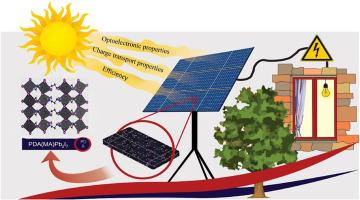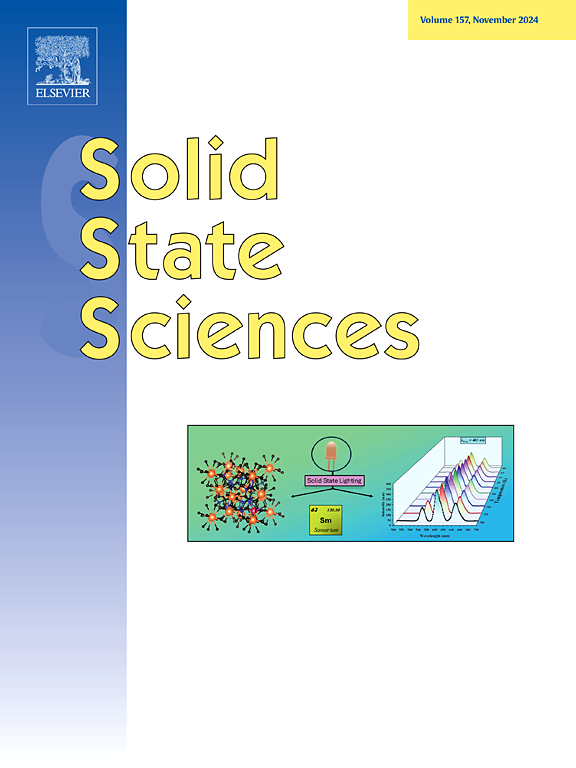Exploration and control of short-chain spacer cations propylammonium and propanediammonium for tuning structure property performance relationships in 2D perovskites
IF 3.3
3区 化学
Q2 CHEMISTRY, INORGANIC & NUCLEAR
引用次数: 0
Abstract
The structural diversity of 2D perovskites, resulting from the integration of various spacer cations, remains insufficiently explored, necessitating a thorough investigation into the mechanisms that govern their structural, optoelectronic, surface moisture resistance, mechanical stability, and photovoltaic performance. This study examines the use of short-chain spacer cations to adjust and control these properties. We analyse the impact of Propylammonium (PA+) and Propanediammonium (PDA2+) on the structure-property-performance relationships in Ruddlesden-Popper-type (PA2(MA)Pb2I7) and Dion-Jacobson-type (PDA(MA)Pb2I7) perovskites, based on first-principles calculations. Our results demonstrate that incorporating PDA2+ yields shorter intercalation distances, a higher volumetric density (3.87 g/cm3), and a more compact structure, resulting in monoclinic symmetry and a narrower band gap (1.8 eV). This configuration enhances absorption and charge carrier transport by lowering the excitation binding energy, resulting in a more pronounced Rashba effect due to reduced symmetry. This, in turn, enhances carrier lifetime through indirect transitions. These factors contribute to a higher short-circuit current density (19.64 mA/cm2) and better SLME efficiency (27 %) compared to that of PA2(MA)Pb2I7 (11.16 mA/cm2, 19 %), which adopts a less compact orthorhombic structure (3.17 g/cm3) with a wider band gap (2.17 eV). Mechanical analysis reveals that both perovskites are ductile, with the PDA2+-based perovskite showing greater rigidity and fracture resistance. In contrast, the PA+ cation induces higher ductility, as well as a higher water migration barrier and better resistance to water absorption compared to the PDA2+ cation. These results highlight the crucial importance of spacer cation selection and crystalline symmetry in determining the properties of 2D perovskites.

探索和控制短链间隔阳离子丙基铵和丙二铵对二维钙钛矿结构性能关系的调节作用
二维钙钛矿的结构多样性,由于各种间隔阳离子的整合,仍然没有得到充分的探索,需要对其结构,光电,表面抗湿性,机械稳定性和光伏性能的控制机制进行彻底的研究。本研究探讨了使用短链间隔阳离子来调节和控制这些性质。基于第一线原理计算,分析了丙基铵(PA+)和丙二铵(PDA2+)对ruddlesden - popper型(PA2(MA)Pb2I7)和dion - jacobson型(PDA(MA)Pb2I7)钙钛矿结构-性能-性能关系的影响。我们的研究结果表明,加入PDA2+可以产生更短的插层距离,更高的体积密度(3.87 g/cm3)和更紧凑的结构,从而产生单斜对称和更窄的带隙(1.8 eV)。这种结构通过降低激发结合能来增强吸收和电荷载流子输运,由于对称性降低而产生更明显的Rashba效应。这反过来又通过间接跃迁提高了载流子寿命。与PA2(mA)Pb2I7 (11.16 mA/cm2, 19%)相比,这些因素导致了更高的短路电流密度(19.64 mA/cm2)和更好的SLME效率(27%),PA2(mA)Pb2I7采用了更紧凑的正交结构(3.17 g/cm3)和更宽的带隙(2.17 eV)。力学分析表明,两种钙钛矿均具有延展性,其中PDA2+基钙钛矿具有更大的刚性和抗断裂能力。相比之下,与PDA2+阳离子相比,PA+阳离子具有更高的延展性,以及更高的水迁移屏障和更好的吸水性能。这些结果突出了间隔离子选择和晶体对称性在确定二维钙钛矿性质中的关键重要性。
本文章由计算机程序翻译,如有差异,请以英文原文为准。
求助全文
约1分钟内获得全文
求助全文
来源期刊

Solid State Sciences
化学-无机化学与核化学
CiteScore
6.60
自引率
2.90%
发文量
214
审稿时长
27 days
期刊介绍:
Solid State Sciences is the journal for researchers from the broad solid state chemistry and physics community. It publishes key articles on all aspects of solid state synthesis, structure-property relationships, theory and functionalities, in relation with experiments.
Key topics for stand-alone papers and special issues:
-Novel ways of synthesis, inorganic functional materials, including porous and glassy materials, hybrid organic-inorganic compounds and nanomaterials
-Physical properties, emphasizing but not limited to the electrical, magnetical and optical features
-Materials related to information technology and energy and environmental sciences.
The journal publishes feature articles from experts in the field upon invitation.
Solid State Sciences - your gateway to energy-related materials.
 求助内容:
求助内容: 应助结果提醒方式:
应助结果提醒方式:


